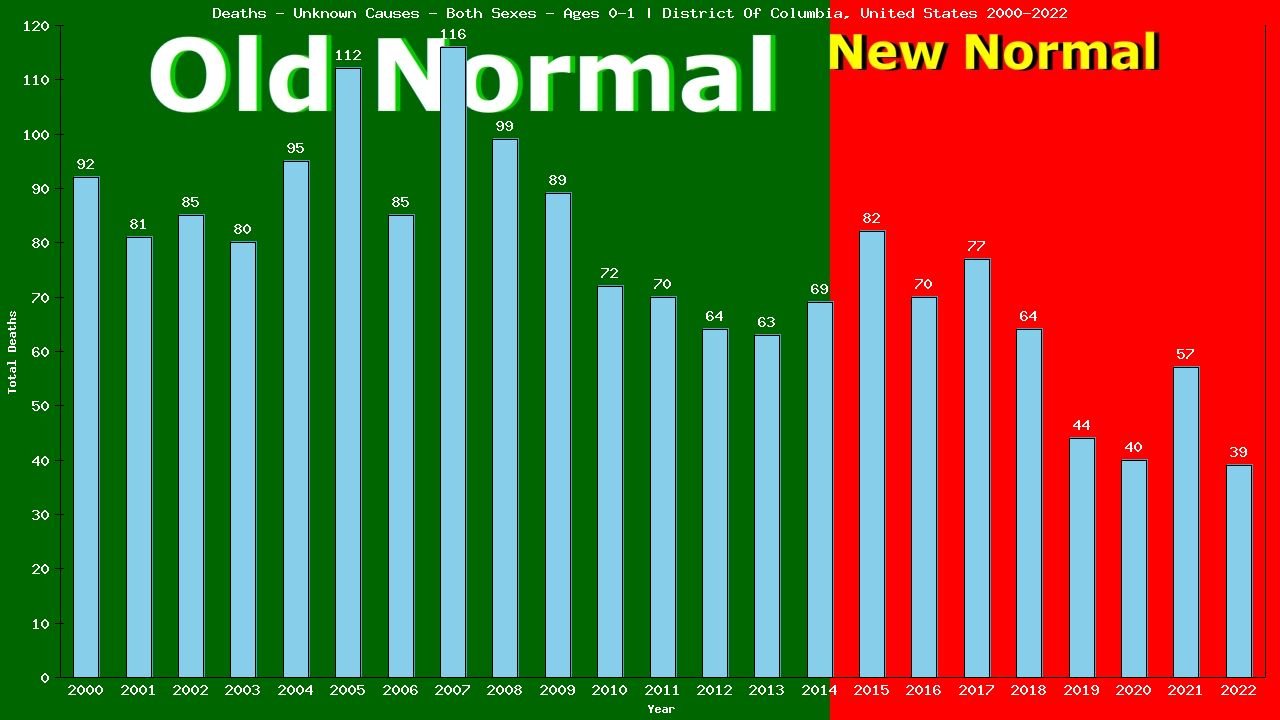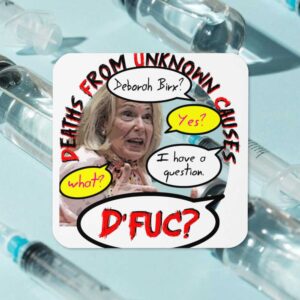Lives Saved
Quick Links
- There were a total of 5,349 deaths in District Of Columbia in 2022
- 39 of all deaths were among those in their first year of life
- 3,726 of all deaths were from Unknown Causes
- 39 deaths from Unknown Causes were among those in their first year of life
39 deaths from Unknown Causes were among babies in their first year of life
2022 vs New Normal™ for babies in their first year of life in District Of Columbia
- 39 of 39 total deaths were from Unknown Causes
- 99.97% of all deaths were from Unknown Causes
- This is down 57% compared to Old Normal rates.
- 91 of 92 total deaths would have been expected under Old Normal conditions.
- 52 fewer than expected deaths from Unknown Causes in 2022.
- 53 fewer than expected All Cause deaths in 2022.
- 339 fewer than expected deaths from Unknown Causes (2015-2022)
- 353 fewer than expected All Cause deaths over the first 8 years of District Of Columbia’s New Normal™.
- To show this year’s deaths from Unknown Causes are down 57% compared to Old Normal rates, we need to calculate the rates for both 2022 and for the Old Normal.
Remember, death rates are calculated to answer these questions:
- “How many babies in their first year of life were there?” and
- “How many of them died from Unknown Causes?”
The following 2 charts provide this information:
Deaths – Unknown Causes – Both Sexes – In Their First Year Of Life | District Of Columbia, United-states

Population – Both Sexes – In Their First Year Of Life – [2000-2022] | District Of Columbia, United-states
![Graph showing Population - Both Sexes - In Their First Year Of Life - [2000-2022] | District Of Columbia, United-states](/wp-content/plugins/dfuc-display/charts/united-states/district-of-columbia/2022/all/Both Sexes/0-1-pop.png)
From the charts, we can see that in 2022, 39 of 8,261 babies in their first year of life living in District Of Columbia died from Unknown Causes.
39 ÷ 8,261 = 0.00472 (2022 CDR)
Deaths/100,000 Both Sexes 0-1 from Unknown Causes

The table shows there were a total of 1,272 deaths from Unknown Causes among 116,004 babies in their first year of life living in District Of Columbia in the 15 years immediately prior to the New Normal™.
1,272 ÷ 116,004 = 0.01097 (Old Normal CDR)
We can use the Old Normal rate to predict this year’s deaths:
2022 pop X Old Normal CDR = expected deaths
8,261 X 0.01097 = 91 expected deaths
The difference between actual and expected deaths shows lives saved or lost:
39 – 91 = -52
Dividing the actual deaths by the expected deaths gives us the comparative rates:
39 ÷ 91 = 0.4302
This reveals 52 lives saved and is 43.02% of what we expected (a decrease of 57%) in deaths from Unknown Causes among babies in their first year of life living in District Of Columbia in 2022, as compared to the Old Normal.
This is the same method used by Public Health to calculate the 5-yr CDR (Cumulative Death Rate):
434 ÷ 65,802 = 0.00660 (5-yr CDR)
8,261(2022 pop) X 0.00660 = 54 expected deaths
The difference between actual and expected deaths:
39 – 54 = -15 or 15 lives saved
Divide actual deaths by expected deaths:
39 ÷ 54 = 0.7147 or a decrease of 29%
for deaths from Unknown Causes among babies in their first year of life living in District Of Columbia in 2022, as compared to the previous 5 years.
Compare our Old Normal to the 5yr CDR. Does it tell the same story your TV does?
Finally, the same method can also be used to compare our Old Normal rate to the New Normal™ rate:
New Normal™ population X Old Normal rate = expected deaths
74,063 X 0.01097 = 812 expected deaths
The difference between actual and expected deaths:
473 – 812 = -339 or 339 lives saved
Dividing the actual deaths by the expected deaths:
473 ÷ 812 = 0.5819 or a decrease of 42%
in deaths from Unknown Causes among babies in their first year of life living in District Of Columbia in the New Normal™, as compared to the Old Normal.
The world has been led to believe that a deadly pandemic swept the globe beginning in 2020, causing an increase in death rates, especially among the elderly
The data show that death rates began to increase in 2015, immediately upon implementation of the UN’s 2030 Agenda for Sustainable Development, that young adults have experienced ever-increasing death rates since, and that death rates among the elderly have remained relatively stable.
Return to the top of the page to select another age category.
×









